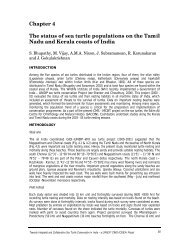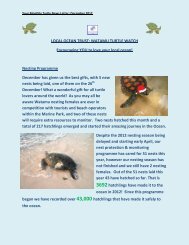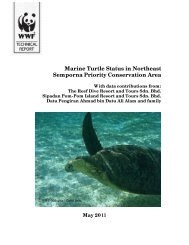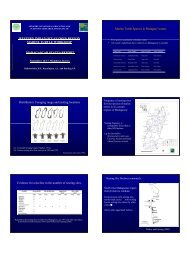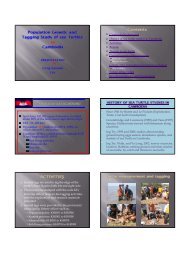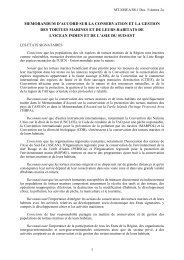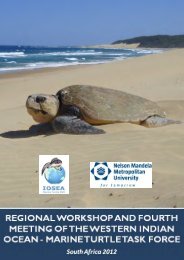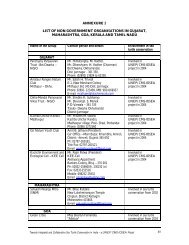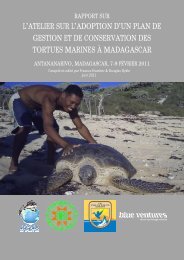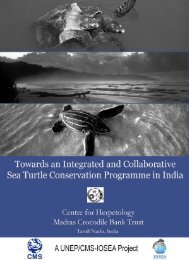Chapter 2 The status of sea turtle populations on the Gujarat coast of ...
Chapter 2 The status of sea turtle populations on the Gujarat coast of ...
Chapter 2 The status of sea turtle populations on the Gujarat coast of ...
Create successful ePaper yourself
Turn your PDF publications into a flip-book with our unique Google optimized e-Paper software.
measured from <strong>the</strong> anterior tip at <strong>the</strong> point <str<strong>on</strong>g>of</str<strong>on</strong>g> <strong>the</strong> nuchal scute to <strong>the</strong> posterior tip <str<strong>on</strong>g>of</str<strong>on</strong>g> <strong>the</strong> supra-caudal.Curved carapace width was measured at <strong>the</strong> widest part <str<strong>on</strong>g>of</str<strong>on</strong>g> <strong>the</strong> carapace.Sand miningIncidence <str<strong>on</strong>g>of</str<strong>on</strong>g> sand mining was recorded al<strong>on</strong>g <strong>the</strong> index beaches and magnitude <str<strong>on</strong>g>of</str<strong>on</strong>g> this impact wasassessed in two ways: (1 ) Based <strong>on</strong> <strong>the</strong> frequency <str<strong>on</strong>g>of</str<strong>on</strong>g> occurrence (i.e encounter rate/km), and (2) Locati<strong>on</strong><str<strong>on</strong>g>of</str<strong>on</strong>g> mining closer to <strong>the</strong> nesting beaches. Subjective rating was given to sand mining based <strong>on</strong> <strong>the</strong>frequency <str<strong>on</strong>g>of</str<strong>on</strong>g> occurrence: low = 1 (two incidences/1 km), medium = (3-4 incidences /1 km) and high = 3(> 4 incidences/1 km). Sand mining locati<strong>on</strong> was rated as: low = (landward side <str<strong>on</strong>g>of</str<strong>on</strong>g> <strong>the</strong> <strong>coast</strong>), Medium =(<strong>on</strong> <strong>the</strong> <strong>coast</strong>) and high = (<strong>on</strong> <strong>the</strong> nesting beach). Overall impact was assessed based <strong>on</strong> <strong>the</strong> relativepercent <str<strong>on</strong>g>of</str<strong>on</strong>g> frequency <str<strong>on</strong>g>of</str<strong>on</strong>g> occurrence in different impact z<strong>on</strong>es.Data analysisAll <strong>the</strong> analyses were based <strong>on</strong> <strong>on</strong>ly very fresh nests recorded from 14 index beaches. Since m<strong>on</strong>itoringfrequency varied from seven days to 30 days gap, <strong>the</strong> estimated nesting density was found to be very low.<str<strong>on</strong>g>The</str<strong>on</strong>g>refore nesting density was calculated based <strong>on</strong> <strong>the</strong> following factors: (1) Even though moderatelyfresh nests were also recorded, <strong>on</strong>ly very fresh nests were used for density estimati<strong>on</strong> (2) Relative densitywas estimated based <strong>on</strong> <strong>on</strong>ly <strong>the</strong> number <str<strong>on</strong>g>of</str<strong>on</strong>g> very fresh nests and number <str<strong>on</strong>g>of</str<strong>on</strong>g> m<strong>on</strong>itoring days for overall<strong>coast</strong>al density, and (3) Index Beach specific density was estimated by extrapolati<strong>on</strong> for each m<strong>on</strong>th.Nesting survey carried out by <strong>the</strong> GSFD under <str<strong>on</strong>g>sea</str<strong>on</strong>g> <str<strong>on</strong>g>turtle</str<strong>on</strong>g> hatchery development has been discussedseparately.RESULTSNETWORKING OF STAKEHOLDERSA total <str<strong>on</strong>g>of</str<strong>on</strong>g> 32 stretches/villages were rapidly surveyed in four <strong>coast</strong>al districts and five types <str<strong>on</strong>g>of</str<strong>on</strong>g>stakeholders were identified. <str<strong>on</strong>g>The</str<strong>on</strong>g>y were representatives <str<strong>on</strong>g>of</str<strong>on</strong>g> NGO groups, GSFD staff, <strong>coast</strong>al villagers,fisherfolk and o<strong>the</strong>rs (naturalists). <str<strong>on</strong>g>The</str<strong>on</strong>g>se different groups <str<strong>on</strong>g>of</str<strong>on</strong>g> people were briefed about <strong>the</strong> importance <str<strong>on</strong>g>of</str<strong>on</strong>g><strong>the</strong> project and c<strong>on</strong>servati<strong>on</strong> <str<strong>on</strong>g>of</str<strong>on</strong>g> <str<strong>on</strong>g>sea</str<strong>on</strong>g> <str<strong>on</strong>g>turtle</str<strong>on</strong>g>s al<strong>on</strong>g <strong>the</strong> <strong>Gujarat</strong> <strong>coast</strong>. <str<strong>on</strong>g>The</str<strong>on</strong>g>y were also briefed about <strong>the</strong>ir rolein <strong>the</strong> project and <strong>the</strong> work involved. In total 79 people <str<strong>on</strong>g>of</str<strong>on</strong>g> different stakeholder groups were c<strong>on</strong>tacted.<str<strong>on</strong>g>The</str<strong>on</strong>g>se included 18 forest department staff (FD), 24 fisherfolk (FF), 20 <strong>coast</strong>al villagers (CV), and 12representatives <str<strong>on</strong>g>of</str<strong>on</strong>g> six NGOs (Table 2.3). In additi<strong>on</strong> five naturalists from <strong>the</strong> area also showed interest inbeing part <str<strong>on</strong>g>of</str<strong>on</strong>g> <strong>the</strong> <str<strong>on</strong>g>sea</str<strong>on</strong>g> <str<strong>on</strong>g>turtle</str<strong>on</strong>g> c<strong>on</strong>servati<strong>on</strong> network (Annexure 1).Table 2.3: Details <str<strong>on</strong>g>of</str<strong>on</strong>g> Stakeholders involved in networkingCoastal districtNo <str<strong>on</strong>g>of</str<strong>on</strong>g> villagesTypes <str<strong>on</strong>g>of</str<strong>on</strong>g> stakeholderssurveyed FDS FF CV NGO OKachchh 6 8 4 4 3 4Jamnagar 12 2 8 4 6Porbandhar 8 4 6 10 3Junagadh 6 4 6 2 1Total 32 18 24 20 12 5FDS- Forest Department Staff, FF – Fisherfolk, CV-Coastal Villagers, NGO – N<strong>on</strong> GovernmentOrganisati<strong>on</strong>, O – O<strong>the</strong>rsNGO involvementDuring <strong>the</strong> stakeholder identificati<strong>on</strong> survey, a few NGOs like Panchjany Pariyavaran Trust - Bet Dwarka,Amateur Rangers Nature Club, Mithapur – Okha, Okha -Mandal Pariyavaran Vikas Trust in Jamnagardistrict, Kachba Unchar Kendra – Madhavpur, <str<strong>on</strong>g>of</str<strong>on</strong>g> Porbandhar district showed great interest inparticipating in <strong>the</strong> <str<strong>on</strong>g>sea</str<strong>on</strong>g> <str<strong>on</strong>g>turtle</str<strong>on</strong>g> c<strong>on</strong>servati<strong>on</strong> network. In additi<strong>on</strong>, Gir Youth Nature Club <str<strong>on</strong>g>of</str<strong>on</strong>g> Amreli districtTowards Integrated and Collaborative Sea Turtle C<strong>on</strong>servati<strong>on</strong> in India – a UNEP/CMS-IOSEA Project 24



